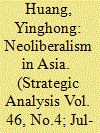|
|
|
Sort Order |
|
|
|
Items / Page
|
|
|
|
|
|
|
| Srl | Item |
| 1 |
ID:
163378


|
|
|
|
|
| Summary/Abstract |
In this article, land acquisition (LA) in India and China since the 1980s has been theorised as an ‘ideal’ model, namely, compulsory development, which highlights the extremely active role of the state and the compulsory measures it takes for LA in both countries in order to achieve its development goals. In both countries, the state acts as the land use planner, regulation maker in the land administration, as well as a major land developer and most influential player in the land market. At the same time, it extracts a high proportion of the benefits from land development projects, which is realised through compulsory LA despite the numerous flaws in the LA institutions. Compulsory development, as we term it, is a key feature in the political economy of LA in both countries. It provides an ideal model to understand and compare the phenomenon of LA in these two largest developing societies and to develop a systematic analysis of LA, and more broadly, of development in both countries. As the initial product in a larger research project, in this article we focus mainly on the theoretical model of this compulsory development, including its definition, characteristics and variations.
|
|
|
|
|
|
|
|
|
|
|
|
|
|
|
|
| 2 |
ID:
187758


|
|
|
|
|
| Summary/Abstract |
Through the lens of land acquisition by the State for development in India and China, an extensively and compulsorily strong State intervention has been witnessed. It pushes forward asymmetric neoliberal reforms, draws value surpluses from land development, and frequently uses mandatory coercive measures, when necessary, to accelerate the economic development process. The current reform has not substantially revised, but in fact, has sustained this model of development. It is a combination of a developmental State in the neoliberal era along with a well-controlled market mechanism, which constitutes the basic features of Asian neoliberalism and distinguishes itself from its Western counterparts.
|
|
|
|
|
|
|
|
|
|
|
|
|
|
|
|
|
|
|
|
|